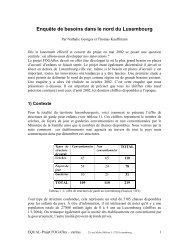Die Entwicklung integrierter familienunterstützender - Qualiflex.lu
Die Entwicklung integrierter familienunterstützender - Qualiflex.lu
Die Entwicklung integrierter familienunterstützender - Qualiflex.lu
You also want an ePaper? Increase the reach of your titles
YUMPU automatically turns print PDFs into web optimized ePapers that Google loves.
England – 2. In-depth description of selected programmes and services<br />
quently, links between the two are strong enough to ensure seamless delivery<br />
of services. The headteacher, for example, stands on the vo<strong>lu</strong>ntary management<br />
committee. Funding is provided by many different agencies, although<br />
its primary sources of revenue are the local authority and Barnardos<br />
(the original managing organisation). The local authority provides funds in<br />
the form of daycare, nursery provision and New Opportunities Fund grants<br />
(TDA-Case Study: Four Acres primary school, 2005).<br />
2.5 Which of these services are organised<br />
according to market principles, how much<br />
weight do they carry within larger institutions,<br />
and to what degree are they supported and<br />
integrated or linked with other services?<br />
The Sure Start programme is largely based on market principles, as it creates<br />
incentives for communities to incorporate private and independent services<br />
into their publicly funded child welfare programmes. Funding for many<br />
childcare services comes from a variety of sources. The Sure Start, Extended<br />
Schools and Childcare Group provides a directory of funding<br />
sources to which parents and local communities can apply according to their<br />
needs. In addition, Sure Start makes use of a range of providers, from the<br />
local to the national level in maintained, private and vo<strong>lu</strong>ntary sectors. For a<br />
example, in the vo<strong>lu</strong>ntary sector the Red Cross, ChildLine UK, Kidscape,<br />
and the National Children’s Bureau all work in tandem with Sure Start programmes<br />
and with schools.<br />
In the private sector, private childminders are encouraged to join networks<br />
based on Children’s Centres and Extended Schools. Responsibility<br />
for organising these networks is delegated to local authorities, while funding<br />
opportunities are offered by the national government. In addition, the government<br />
offers tax credits for disadvantaged parents and funding for a<br />
Business Support Officer (BSO) who liaises with local authorities to help<br />
them apply for further funding.<br />
Thus, Sure Start as a whole aims to make use of the resources already<br />
available in the private, independent and vo<strong>lu</strong>ntary sectors by providing an<br />
integrative framework in which, ideally, all sectors, public and private, can<br />
support each other.<br />
One important feature of the childcare strategy has been the Childcare<br />
Tax Credit (CCTC). In an effort to make childcare providers self-sufficient,<br />
the government offers capital funding and short-term revenue funding as<br />
start-up aid, but expects providers to rely henceforth on parent fees. Parents<br />
could then theoretically claim CCTC to reduce the cost. Knowledge of this<br />
tax scheme varies across sectors and geographical areas, making it difficult<br />
to assess its effect (Smith, 2007). However, the CCTC is not without its<br />
critics. Some unions and tax experts suggest that the tax credit could have<br />
19



